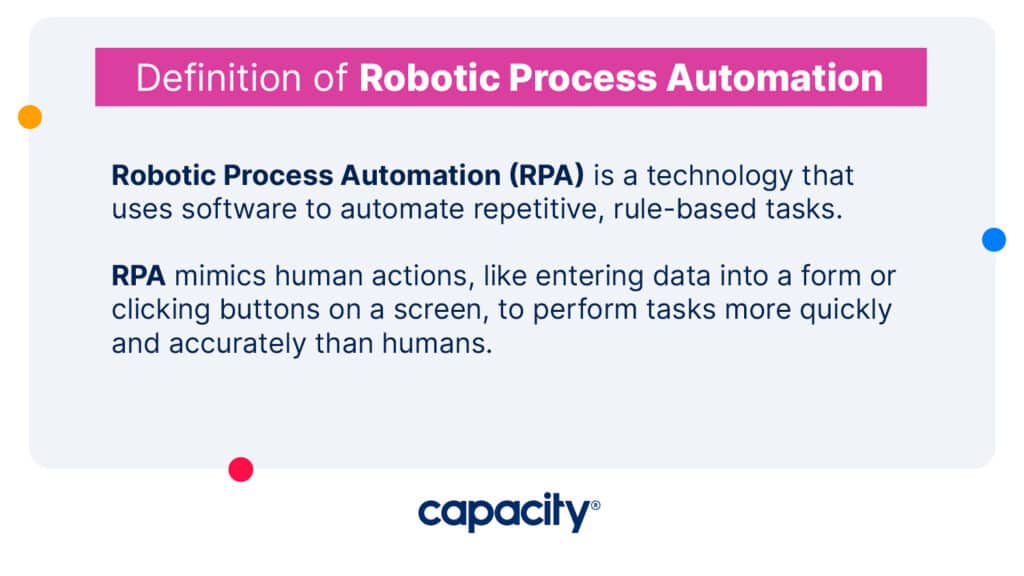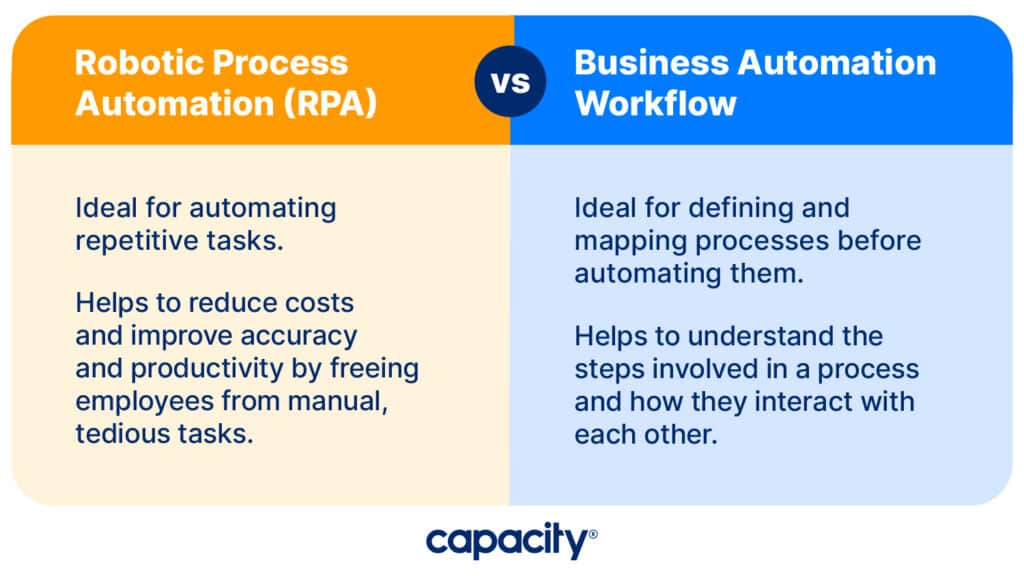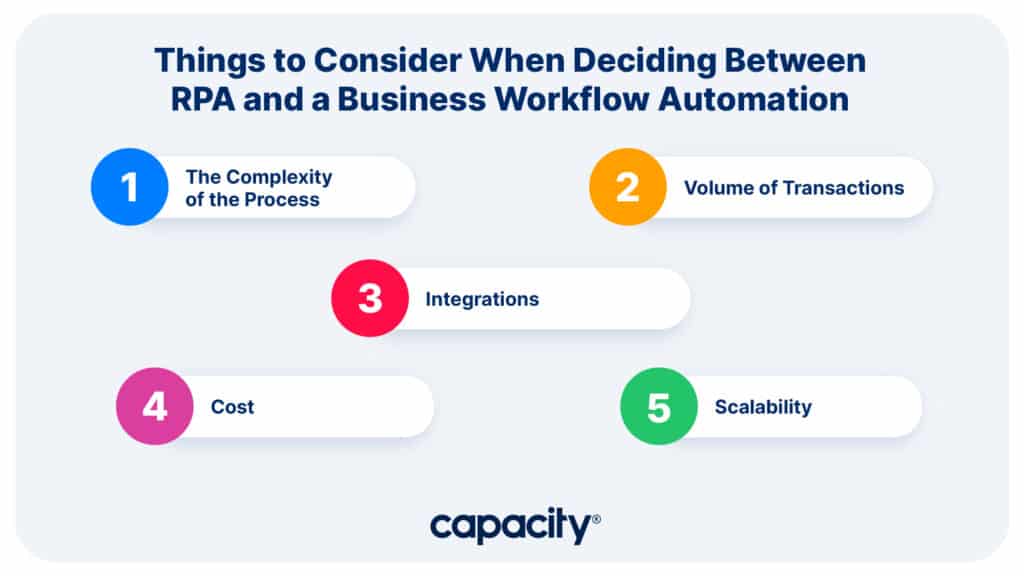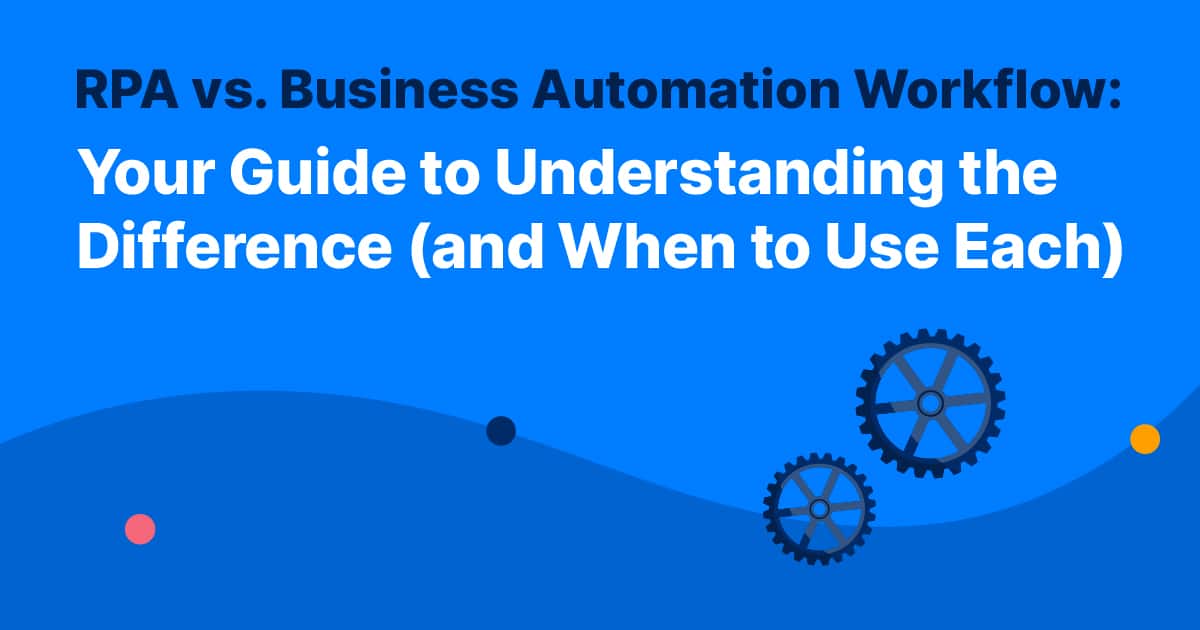Have you ever bought furniture from IKEA or Wayfair? You get all the pieces you need in the package. And (usually…) you get instructions on how to put the pieces together, but you’re responsible for the process.
That’s exactly how RPA and a business automation workflow work together.
RPA, which stands for Robotic Process Automation, is a technology that uses software to automate repetitive, rule-based tasks. It mimics human actions, like entering data into a form or clicking buttons on a screen, to perform tasks more quickly and accurately than humans. It’s the nuts, bolts, screws, and hex keys you need to assemble your IKEA bookshelf.

Automate Your Work
Capacity’s enterprise AI chatbot can help:
- Answer FAQs anytime, anywhere
- Find relevant documents within seconds
- Give surveys and collect feedback
On the other hand, a business automation workflow is a visual representation of the entire business process. It includes all the tasks and decision points involved in the process. And it provides a structured framework for automating a business process, breaking it down into discrete steps and IDing the inputs and outputs for each step. This is your instruction booklet for that shelf.
So, while RPA is a specific technology used to automate tasks, a business automation workflow is a broader framework for automating a business process that may incorporate RPA or other technologies.
RPA and business automation workflows are powerful tools for quickly and efficiently automating mundane tasks. Though they have similarities, they also differ in a few ways. So let’s break it down by covering what each is, their differences, and how they work together.

What is RPA?
RPA is a technology that lets you automate repetitive and mundane tasks using software robots (aka – bots).
These bots are programmed to perform tasks previously done manually by humans. Think of things like data entry, copying and pasting info between several applications, or moving files from one place to another. RPA bots can work round-the-clock without any dip in productivity, making them ideal for handling large volumes of work with insane precision, accuracy, and speed.
Industries like finance, healthcare, manufacturing, and retail are some of the biggest adopters of RPA. But in reality, most companies and industries can hop onto the auto-bot train to help cut costs, increase efficiency, and improve process quality. In fact, according to Deloitte’s Global RPA Survey, payback was reported at less than 12 months, with an average of 20% of FTE capacity provided by robots. What’s more, RPA has helped to improve compliance (92%), quality and accuracy (90%), and productivity (86%).
Now, let’s look at a business automation workflow and its use with RPA.
What’s a business automation workflow?
A business automation workflow visually represents the steps and actions you need to take to automate your business processes. It documents the inputs and outputs for each step. And it also outlines the flow of information, tasks, and decision-making involved in the process. Like RPA, it can help you finish your mundane, time-suck tasks.
You can use business automation workflows to automate tasks like onboarding new customers or completing payroll. You can also process invoices and payments or track customer service calls. Automated workflows are excellent for large companies that handle high volumes of data.
So, while RPA is the tool you use to automate tasks, the business automation workflow gives instructions on how and when to use it. Think back to your IKEA instruction booklet. It tells you exactly what pieces to put together, in which order, and how they should look. Just like the automation workflow.
When to use RPA vs. a Business Automation Workflow
Now that you know what RPA and a business automation workflow are, let’s look at when it makes sense to use each.

RPA is ideal for automating repetitive tasks – like data entry or copy-pasting information between several applications. It helps to reduce costs and improve accuracy and productivity by freeing employees from manual, tedious tasks.
And then, you use a business automation workflow to define and map processes before automating them. It helps you to understand the steps involved in a process and how they interact with each other.
What to consider when deciding between RPA and a business workflow automation

Before you decide whether you need RPA or an entire business workflow automation, start by documenting your specific needs and prereqs of the process you’re trying to automate. Here are some things to consider:
The complexity of the process
A business automation workflow may be more suitable if the process involves complex decision-making and requires human judgment. It can incorporate decision points and approval processes. RPA, on the other hand, is better for repetitive and rule-based tasks.
Volume of transactions
If the process involves a high volume of transactions or data, RPA may be more efficient in completing the tasks quickly and accurately. Automation workflows can handle high volumes too. But they may need more development and configuration efforts.
Integrations
If the process requires integration with other systems or applications, a business automation workflow may be more appropriate as it can provide a more comprehensive integration. But RPA can also integrate with other systems but may need more configuration and custom development.
Cost
RPA can be an attractive option for businesses with limited budgets. It’s fast to stand up, and there’s a low barrier to entry. In contrast, an automation workflow might need more significant dev efforts. And its implementation costs may be higher.
Scalability
If the process needs to be scalable, a business automation workflow may be more suitable as it can handle more complex processes and significant volumes. But, you can scale RPA by adding more bots or virtual machines to handle higher volumes.
Both RPA and business automation workflows can automate business processes. But your choice depends on your specific needs and requirements.
Check out our RPA solution here. Or give Capacity a try for free now!





